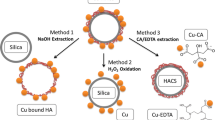Abstract
Dissolved organic matter (DOM) in soil solution is considered to interact with herbicides enhancing their mobility and promoting subsequent leaching.
Batch experiments were conducted to test if free and DOM-bound herbicides can be separated by a DOM-flocculation technique with Cu as a coagulant.
DOM was extracted from the H and A horizons of two soils (Terric Histosol, Cumuli-Calcaric Cambisol) and from the O horizon of a forest soil (Humic Cambisol). DOM-solutions (100 mL) were fortified with the herbicides terbuthylazine and pendimethalin (100 μg active ingredient each) and equilibrated for 14 hours. After DOM-flocculation with Cu (addition of 0,5 mM CuCl2) herbicide recovery was determined in the supernatant solutions and in the precipitate of Humic Cambisol-DOM, respectively.
Recovery of the herbicides from pure water was 85–99% and was not influenced by the addition of Cu. At low pH (4,8–5,3) DOM-flocculation of different DOM-extracts was insufficient and varied in a range of 18 – 90%. Herbicide recovery from DOM-solutions decreased moderately for terbuthylazine (60–90%) and strongly for pendimethalin (5 – 30%). In general, the addition of Cu caused no further reduction of herbicide recovery from supernatant solutions, except for Humic Cambisol-DOM. The effects of Cu-addition were most evident for pendimethalin (strongly reduced concentration in the supernatant solutions) and were considered to be caused by a flocculation of DOM-bound moieties. Flocculation of Humic Cambisol-DOM increased from 18 – 24% at pH 5 to > 95% at pH 8. However, at this pH the formation of Cu(OH)2 as a sorbing subcomponent of the flocculated matter lead to an overestimation of DOM-bound pendimethalin. Calculating this side effect 6% of pendimethalin added was DOM-bound. Only traces of terbuthylazine (< 1%) were found in the solid matter of flocculated Humic Cambisol-DOM.
To sum up, the new approach to separate freely dissolved herbicides from DOM-bound moieties not fully corresponded to our expectations. DOM-flocculation was found to depend strongly on pH-environment influencing not only DOM-herbicide interactions but also the clear separation of DOM-bound herbicides from herbicides in solutions.
Similar content being viewed by others
References
Carter, C.W.;I.H. Suffet (1982): Binding of DDT to Dissolved Humic Materials. Environ. Sci. Technol.16, 735–740
Chiou, C.T.;D.E. Kile;T.I. Brinton;R.L. Malcom;J.A. Leenheer (1987): A comparison of water solubility enhancements of organic solutes by aquatic humic material and commercial humic acids. Environmental Science & Technology18, 916–922
Dankwardt, A.;B. Hock;R. Simon, D. Freitag;D. Kettrup (1996): Determination of non-extractable triazin residues by enzyme immunoassay: Investigation of model compounds and soil fulvic and humic acids. Environmental Science & Technology30, 3493–3500
Decock, P.;B. Dubois;J. Lerivrey;C. Gessa;J. Urbanksa;H. Kozlowski (1985): Cu(II) Binding by substituted 1,3,5-triazine herbicides. Inorganica Chimica Acta107, 63–66
Gamble, D.S.;M.I. Haniff;R.H. Zienius (1986): Solution Phase Complexing of Atrazine by Fulvic Acid: A Batch Ultrafiltration Technique. Anal. Chem.58, 727–731
Gauthier, T.D.;E.C. Shane;W.F. Guerin;W.R. Scitz, C.L. Grant (1986): Flourescence quenching method for determining equilibrium constants for polycyclic aromatic hydrocarbons binding to dissolved humic materials. Environ. Sci. Technol.20, 1162–1166
Govi, M.;A. Sarti;E. Di Martino;C. Ciavatta;N. Rossi (1996): Sorption and Desorption of Herbicides by Soil Humic Acid Fractions. Soil Science161, 265–269
Haniff, M.I.;R.H. Zienius;C.H. Langford;D.S. Gamble (1985): The solution phase complexing of atrazine by fulvic acid: Equilibria at 25°C. J. Environ. Sci. Health B20, 215–226
Hayes, M.H.B. (1970): Adsorption of triazine herbicides on soil organic matter, including a short review on soil organic matter chemistry. Residue Review32, 131–174
Johnson, W.E.;N.J. Fendinger;J.R. Plimmer (1991): Solid-Phase Extraction of Pesticides from Water: Possible Interferences from Dissolved Organic Material. Anal. Chem.63, 1510–1513
Kördel, W.;M. Dassenakis;J. Lintelmann;S. Padberg (1997): The importance of natural organic material for environmental processes in waters and soils. IUPAC, Pure and Applied Chemistry69, 1571–1600
Kolouskova, N. (1987): Interaction of Humic Acids with Atrazine. J. Environ. Sci. Health B22, 113–123
Landrum, P.F.;S.R. Nihart;B.J. Eadies;W.S. Gardener (1984): Reverse-Phase Separation Method for Determining Pollutant Binding to Aldrich Humic Acid and Dissolved Organic Carbon of Natural Waters. Environ. Sci. Technol.18, 187–192
Laor, Y.;M. Rebhun (1997): Complexation-flocculation: A new method to determine binding coefficients of organic contaminants to dissolved humic substances. Environmental Science & Technology31, 3558–3564
Madhun, Y.A.;I.L. Young;V.H. Freed (1986): Binding of herbicides by water soluble organic materials from soil. J. Environ. Qual.15, 64–68
Maxin, C.R.;I. Kögel-Knabner (1995): Partitioning of polycyclic aromatic hydro-carbons (PAH) to water-soluble soil organic matter. European Journal of Soil Science46, 193–204
McCarthy, J.F.;B.D. Jiminez (1985): Interaction between polycyclic aromatic hydro-carbons and dissolved humic material: Binding and dissociation. Environ. Sci. Technol.19, 1072–1076
Müller-Wegener, U. (1977): Binding of s-Triazines to Humic Acids. Geoderma19, 227–235
Müller-Wegner, U. (1983): Neue Erkenntnisse zur Wechselwirkung zwischen s-Triazinen und organischen Stoffen in Böden. Dissertation, Universität Göttingen/ Germany
Piccolo, A.;G. Celano;C. De Simone (1992): Interactions of atrazine with humic substances of different origins and their hydrolysed products. The Science of the Total Environment117/118, 403–412
Rebhun, M.;S. Meir;Y. Laor (1998): Using dissolved humic acid to remove hydrophobic contaminants from water by complexationflocculation process. Environ. Sci. Technol.32, 981–986
Schnitzer, M.;S.U. Khan (1972): Humic Substances in the Environment, Marcel-Dekker Verlag, New York, page 225
Schomburg, C.J.;D.E. Glotfelty;J.N. Seiber (1991): Pesticide occurence in fog collected near Monterey, California. Environ. Sci. Technol.25, 155–160
Senesi, N. (1992): Binding mechanisms of pesticides to soil humic substances. The Science of the Total Environment123/124, 63–76
Senesi, N.;G. Brunetti;P. La Cava;T.M. Miano (1994): Adsorption of Alachlor by humic acids from sewage sludge and amended and non-amended soils. Soil Science157, 176–184
Senesi, N.;C. Testini (1980): Adsorption of some Nitrogenated Herbicides by Soil Humic Acids. Soil Science130, 314–320
Stevenson, J.F. (1972): Organic matter reactions involving herbicides in soil. J. Environ. Qual.1, 333–343
Sullivan, J.D. Jr.;G.T. Felbeck, Jr. (1968): A study of the interaction of s-Triazine Herbicides with Humic Acids from three different soils. Soil Science106, 42–52
Author information
Authors and Affiliations
Rights and permissions
About this article
Cite this article
Gießl, H. DOM-Flocculation: A suitable approach for separating free and DOM-bound herbicides?. Environ. Sci. & Pollut. Res. 6, 77–82 (1999). https://doi.org/10.1007/BF02987552
Received:
Accepted:
Issue Date:
DOI: https://doi.org/10.1007/BF02987552




